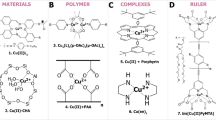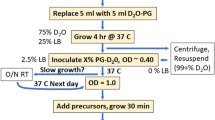Abstract
Hydroxyl protons on serine and threonine residues are not well characterized in protein structures determined by both NMR spectroscopy and X-ray crystallography. In the case of NMR spectroscopy, this is in large part because hydroxyl proton signals are usually hidden under crowded regions of 1H-NMR spectra and remain undetected by conventional heteronuclear correlation approaches that rely on strong one-bond 1H–15N or 1H–13C couplings. However, by filtering against protons directly bonded to 13C or 15N nuclei, signals from slowly-exchanging hydroxyls can be observed in the 1H-NMR spectrum of a uniformly 13C/15N-labeled protein. Here we demonstrate the use of a simple selective labeling scheme in combination with long-range heteronuclear scalar correlation experiments as an easy and relatively inexpensive way to detect and assign these hydroxyl proton signals. Using auxtrophic Escherichia coli strains, we produced Bacillus circulans xylanase (BcX) labeled with 13C/15N-serine or 13C/15N-threonine. Signals from two serine and three threonine hydroxyls in these protein samples were readily observed via 3JC–OH couplings in long-range 13C-HSQC spectra. These scalar couplings (~5–7 Hz) were measured in a sample of uniformly 13C/15N-labeled BcX using a quantitative 13C/15N-filtered spin-echo difference experiment. In a similar approach, the threonine and serine hydroxyl hydrogen exchange kinetics were measured using a 13C/15N-filtered CLEANEX-PM pulse sequence. Collectively, these experiments provide insights into the structural and dynamic properties of several serine and threonine hydroxyls within this model protein.






Similar content being viewed by others
References
Agarwal V, Linser R, Fink U, Faelber K, Reif B (2010) Identification of hydroxyl protons, determination of their exchange dynamics, and characterization of hydrogen bonding in a microcrystallin protein. J Am Chem Soc 132:3187–3195
Baba T, Ara T, Hasegawa M, Takai Y, Okumura Y, Baba M, Datsenko KA, Tomita M, Wanner BL, Mori H (2006) Construction of Escherichia coli K-12 in-frame, single-gene knockout mutants: the Keio collection. Mol Syst Biol 2:2006
Baturin SJ, Okon M, McIntosh LP (2011) Structure, dynamics, and ionization equilibria of the tyrosine residues in Bacillus circulans xylanase. J Biomol NMR 51:379–394
Blake PR, Lee B, Summers MF, Adams MWW, Park JB, Zhou ZH, Bax A (1992) Quantitative measurement of small through-hydrogen-bond and through-space 1H–113Cd and 1H–199Hg J-couplings in metal-substituted rubredoxin from Pyrococcus furiosus. J Biomol NMR 2:527–533
Borisov EV, Zhang W, Bolvig S, Hansen PE (1998) nJ(13C, O1H) coupling constants of intramolecularly hydrogen-bonded compounds. Magn Reson Chem 36:S104–S110
Breeze AL (2000) Isotope-filtered NMR methods for the study of biomolecular structure and interactions. Prog Nucl Magn Reson Spectrosc 36(4):323–372
Clark AJ (1963) Genetic analysis of a “double male” strain of Escherichia coli K-12. Genetics 48:105–120
Connelly GP, Withers SG, McIntosh LP (2000) Analysis of the dynamic properties of Bacillus circulans xylanase upon formation of a covalent glycosyl-enzyme intermediate. Protein Sci 9:512–5242
Creighton TE (2010) The biophysical chemistry of nuclei acids and proteins. Helvetian Press, NY
Delaglio F, Grzesiek S, Vuister GW, Zhu G, Pfeifer J, Bax A (1995) NNMpipe—a multidimensional spectral processing system based on Unix pipes. J Biomol NMR 6(3):277–293
Goddard TD, Kneeler DG (1999) Sparky 3, 3rd edn. University of California, San Francisco, CA
Grzesiek S, Bax A (1993) The importance of not saturating H2O in protein NMR—application to sensitivity enhancement and NOE measurements. J Am Chem Soc 115:12593–12594
Hansen PE (1981) Carbon–hydrogen spin–spin coupling constants. Prog Nucl Magn Reson Spectrosc 14:175–295
Henry GD, Sykes BD (1990) Hydrogen exchange kinetics in a membrane protein determined by 15N NMR spectroscopy: use of the INEPT experiment to follow individual amides in detergent-solubilized M13 coat protein. Biochemistry 29:6303–6313
Ho BK, Agard DA (2008) Identification of new, well-populated amino-acid sidechain rotamers involving hydroxyl-hydrogen atoms and sulfhydryl-hydrogen atoms. BMC Struct Biol 8:41
Hwang TL, Mori S, Shaka AJ, vanZijl PCM (1997) Application of phase-modulated CLEAN chemical EXchange spectroscopy (CLEANEX-PM) to detect water-protein proton exchange and intermolecular NOEs. J Am Chem Soc 119:6203–6204
Ikura M, Bax A (1992) Isotope-filtered 2D NMR of a protein peptide complex—study of a skeletal-muscle myosin light chain kinase fragment bound to calmodulin. J Am Chem Soc 114:2433–2440
Iwahara J, Wojciak JM, Clubb RT (2001) Improved NMR spectra of a protein-DNA complex through rational mutagenesis and the application of a sensitivity optimized isotope-filtered NOESY experiment. J Biomol NMR 19:231–241
Joshi MD, Hedberg A, McIntosh LP (1997) Complete measurement of the pKa values of the carboxyl and imidazole groups in Bacillus circulans xylanase. Protein Sci 6:2667–2670
Joshi MD, Sidhu G, Nielsen JE, Brayer GD, Withers SG, McIntosh LP (2001) Dissecting the electrostatic interactions and pH-dependent activity of a family 11 glycosidase. Biochemistry 40:10115–10139
Knauf MA, Lohr F, Curley GP, O’Farrell P, Mayhew SG, Muller F, Ruterjans H (1993) Homonuclear and heteronuclear NMR studies of oxidized Desulfovibrio vulgaris flavodoxin. Sequential assignments and identification of secondary structure elements. Eur J Biochem 213:167–184
Kossiakoff AA, Shpungin J, Sintchak MD (1990) Hydroxyl hydrogen conformations in trypsin determined by the neutron-diffraction solvent difference map method—relative importance of steric and electrostatic factors in defining hydrogen-bonding geometries. Proc Natl Acad Sci USA 87:4468–4472
Liepinsh E, Otting G (1996) Proton exchange rates from amino acid side chains—implications for image contrast. Magn Reson Med 35:30–42
Liepinsh E, Otting G, Wuthrich K (1992) NMR spectroscopy of hydroxyl protons in aqueous solutions of peptides and proteins. J Biomol NMR 2:447–465
Lohr F, Mayhew SG, Ruterjans H (2000) Detection of scalar couplings across NH···OP and OH···OP hydrogen bonds in a flavoprotein. J Am Chem Soc 122:9289–9295
McIntosh LP, Naito D, Baturin SJ, Okon M, Joshi MD, Nielsen JE (2011) Dissecting electrostatic interactions in Bacillus circulans xylanase through NMR-monitored pH titrations. J Biomol NMR 51:5–19
Muchmore DC, McIntosh LP, Russell CB, Anderson DE, Dahlquist FW (1989) Expression and 15N labeling of proteins for proton and 15N NMR. Methods Enzymol 177:44–73
Ogura K, Terasawa H, Inagaki F (1996) An improved double-tuned and isotope-filtered pulse scheme based on a pulsed field gradient and a wide-band inversion shaped pulse. J Biomol NMR 8:492–498
Peelen S, Vervoort J (1994) Two-dimensional NMR studies of the flavin binding site of Desulfovibrio vulgaris flavodoxin in its three redox states. Arch Biochem Biophys 314:291–300
Piotto M, Saudek V, Sklenar V (1992) Gradient-tailored excitation for single-quantum NMR-spectroscopy of aqueous solutions. J Biomol NMR 2:661–665
Plesniak LA, Connelly GP, Wakarchuk WW, McIntosh LP (1996a) Characterization of a buried neutral histidine residue in Bacillus circulans xylanase: NMR assignments, pH titration, and hydrogen exchange. Protein Sci 5(11):2319–2328
Plesniak LA, Wakarchuk WW, McIntosh LP (1996b) Secondary structure and NMR assignments of Bacillus circulans xylanase. Protein Sci 5(6):1118–1135
Plevin MJ, Hayashi I, Ikura M (2008) Characterization of a conserved “threonine clasp” in CAP-Gly domains: role of a functionally critical OH/π interaction in protein recognition. J Am Chem Soc 130:14918–14919
Segawa T, Kateb F, Duna L, Bodnhausen G, Pelupessy P (2008) Exchange rate constants of invisible proteins in proteins determined by NMR spectroscopy. ChemBioChem 9:537–542
Sung WL, Luk CK, Zahab DM, Wakarchuk W (1993) Overexpression and purification of the Bacillus subtilis and Bacillus circulans xylanases in Escherichia coli. Protein Expr Purif 4:200–216
Takeda M, Jee J, Ono AM, Terauchi T, Kainosho M (2011) Hydrogen exchange study on the hydroxyl groups of serine and threonine residues in proteins and structure refinement using NOE restraints with polar side-chain groups. J Am Chem Soc 133:17420–17427
Ulrich EL, Akutsu H, Doreleijers JF, Harano Y, Ioannidis YE, Lin J, Livny M, Mading S, Maziuk D, Miller Z, Nakatani E, Schulte CF, Tolmie DE, Wenger RK, Yao HY, Markley JL (2008) BioMagResBank. Nucleic Acids Res 36:D402–D408
Velyvis A, Ruschak AM, Kay LE (2012) An economical method for production of 2H, 13CH3-threonine for solution NMR studies of large protein complexes: application to the 670 kDa proteasome. PLoS ONE 7(9):e43725
Waugh DS (1996) Genetic tools for selective labeling of proteins with α-15N-amino acids. J Biomol NMR 8:184–192
Word JM, Lovell SC, Richardson JS, Richardson DC (1999) Asparagine and glutamine: using hydrogen atom contacts in the choice of side-chain amide orientation. J Mol Biol 285:1735–1747
Zwahlen C, Legault P, Vincent SJF, Greenblatt J, Konrat R, Kay LE (1997) Methods for measurement of intermolecular NOEs by multinuclear NMR spectroscopy: application to a bacteriophage lambda N-peptide/boxB RNA complex. J Am Chem Soc 119:6711–6721
Acknowledgments
We thank Simon Baturin for help with preliminary experiments. This research was funded by the Natural Sciences and Engineering Research Council of Canada (NSERC) to LPM. Instrument support was provided by the Canadian Institutes for Health Research (CIHR), the Canada Foundation for Innovation (CFI), the British Columbia Knowledge Development Fund (BCKDF), the UBC Blusson Fund, and the Michael Smith Foundation for Health Research (MSFHR).
Author information
Authors and Affiliations
Corresponding author
Electronic supplementary material
Below is the link to the electronic supplementary material.
Rights and permissions
About this article
Cite this article
Brockerman, J.A., Okon, M. & McIntosh, L.P. Detection and characterization of serine and threonine hydroxyl protons in Bacillus circulans xylanase by NMR spectroscopy. J Biomol NMR 58, 17–25 (2014). https://doi.org/10.1007/s10858-013-9799-6
Received:
Accepted:
Published:
Issue Date:
DOI: https://doi.org/10.1007/s10858-013-9799-6




